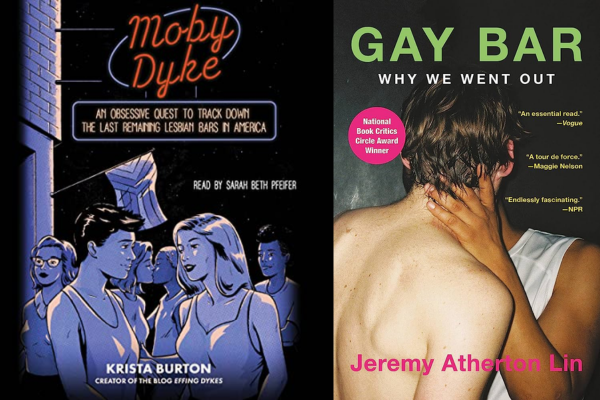Do you remember your first gay bar? Could you have written a book on it, or were you also standing awkwardly at the bar wearing too much lipstick and fidgeting with your keys? Krista Burton’s Moby Dyke: An Obsessive Quest to Hunt Down the Last Remaining Lesbian Bars in America and Gay Bar: Why We Went Out by Jeremy Atherton Lin, describe the challenges facing historically gay and lesbian bars. Both question of the future of queer spaces while giving tremendous insight to a new generation.
These books are part memoir, part socio-historic narrative. We learn about Burton’s coming out and what lesbian bars mean to their communities in Moby Dyke. Gay Bar tells Jeremy Atherton Lin’s experiences in gay bars in San Francisco and London, interspersed with social and historical commentary.
What do current queer spaces look like to these authors? In Gay Bar, Atherton Lin describes a woman demanding to borrow someone’s hat to wear for a “quick gay bar selfie.” Atherton Lin, as an Asian-American, also experiences racial exclusion. “It was a very Caucasian room,” he says of one bar. “The Union Jack bunting I found ostracizing; the American flag made me feel no more welcome.” Several lesbian bar owners inform Burton that their patrons make less money, and therefore less disposable income, than men. Even those with the means to be in these spaces experience objectification; Burton observes “SCUMs” – Solitary Creepy Unwelcome Men – exhibiting predatory behavior towards queer femmes and folks.
“Why are lesbian bars almost solely in charge of being inclusive?” Burton asks, referring in part to the safety practices in historically lesbian bars. At one bar, a SCUM is immediately thrown out by a bartender. At a drag show, consent is announced as mandatory to prioritize the performers’ well-being. However, recalling the appearance of Pride flags in non-gay bars, Atherton Lin is skeptical. “Maybe the flags weren’t just inviting us in, but keeping other certain types at bay.” Many of Burton’s interviewees cherish the feeling of community, knowing that “people are looking out for us and on our side.” Atherton Lin feels differently. “We did not go out to be safe. I didn’t, anyway,” he says. “The idea of a safe space isn’t coherent to me, but then again I now recognize I’m privileged in ways I didn’t previously comprehend. The kids have told me.”
The “kids” are pushing for progressive spaces where all queer experiences belong. “What the fuck does a lesbian look like?” Burton asks in frustration after encountering a hostile bar patron who reads her as straight. “How am I supposed to have a woman-centric space that’s a lesbian bar but also be fully inclusive?” asks the owner of another bar. One bartender, Jorhdon, bridges history with an inclusive view of the future: “To not call this a lesbian bar does a disservice to the reason the bar was created…to be a safe space for lesbians…to ignore that is an erasure.”
It is difficult to create a space that reflects the range of queer experiences. “Infighting can destroy spaces and whole communities,” cautions Burton. Still, space for communities to exist safely in the wake of anti-queer and anti-trans legislation is important. Atherton Lin concedes, “it must mean something to share similar memories of being treated as less than.”
Maybe the answer lies in our actions. We can visit our local queer spaces and advocate for those in need of support. We can be welcoming while having each other’s backs. Burton and Atherton Lin show us that queerness “provides gray areas… space between the little binary categories that have held society hostage.” When we hold ourselves to the limits of our own experiences, we miss the party. Even if it’s mostly spent in the bathroom line at A League of Her Own.


